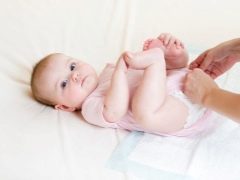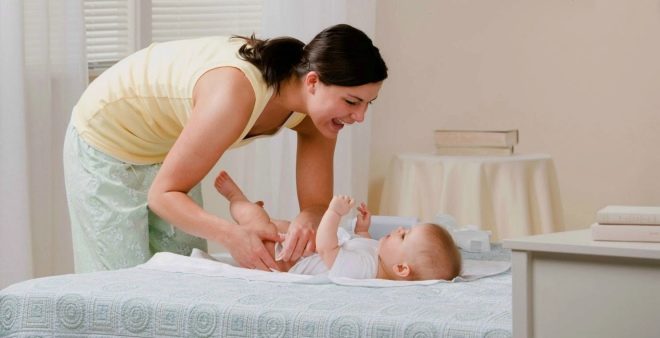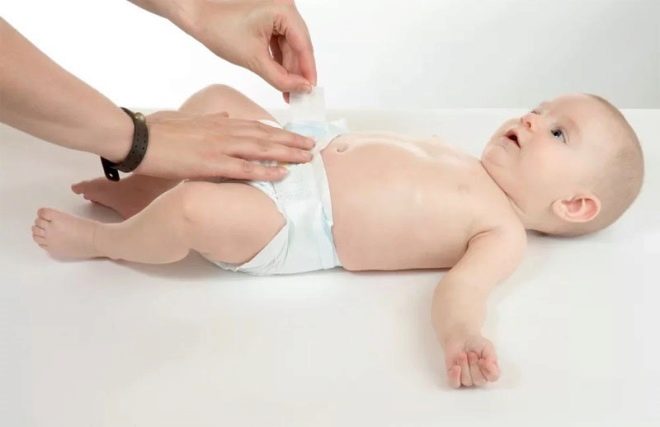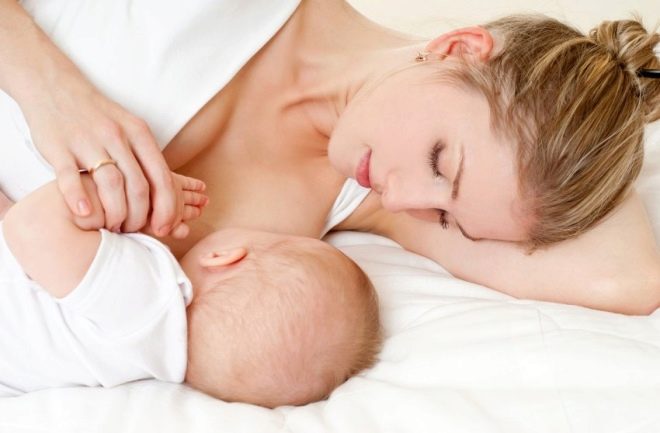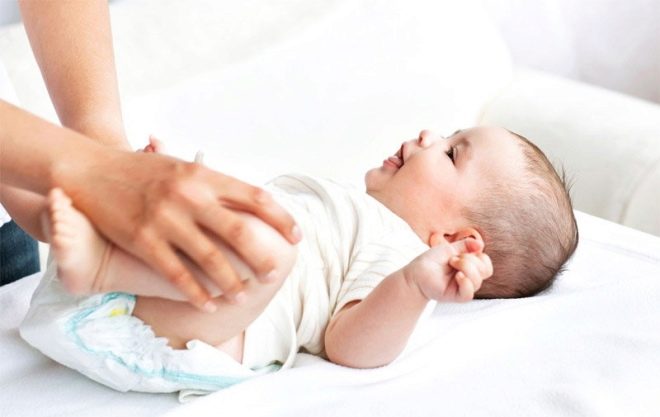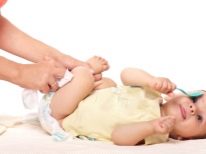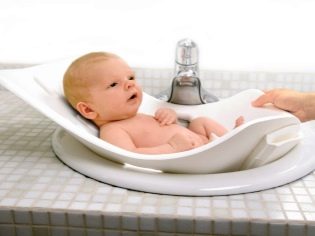How to change the diaper and how often do I need to do it?
Modern parents simply cannot imagine caring for a small child without using disposable diapers. Thanks to them, the baby and mother can sleep peacefully at night. Manufacturers of products for children are trying to improve the diapers in order to increase the comfort of the child. Much depends on the parents, the baby will smile, if you change the means of hygiene in time and correctly.
Replacement frequency
Newborns quite often write about 25 times a day. It makes no sense to change the diaper after each urination, it is worth waiting for its filling. On average, it is worth changing the hygiene product every 2–3 hours. Remember that the first weeks of life the baby's body is cleared of the original feces. After the bowel movement, you need to immediately replace the diaper, even if you literally just put it on.
If you change the disposable diaper too rarely, then the baby’s skin will begin to turn red and inflamed. Prolonged use of a single hygienic product leads to dermatitis, diaper rash, and rash. Bacteria from the feces can get into the genitals and cause the development of infectious diseases. For these reasons, it is necessary to check the cleanliness of the diaper as often as possible. Pampers newborns need to be changed very often, on average, about 20 products are needed per day. A baby from 2 to 6 months should also change the diaper as it is filled, about once every 4-6 hours.
After six months, you can focus on the state of the child and personal views, because at this age you can even wean the child from disposable diapers or use them only for a walk, during sleep.
How to change the baby and what to consider?
Even in the hospital, young mothers are learning to change diapers to babies. Often doctors or nurses can give valuable advice. The most important thing is that before 1 month the gum of a hygienic product does not rub the umbilical wound. You can use special diapers for newborns who have a neckline in this area. To protect the wound on the tummy can be otherwise - just bend the edge of any diaper.
Note that children up to 28 days write very often. It is necessary to hold the hand on the inner surface of the diaper about once per hour, if the product is wet - to replace. The older the baby becomes, the less often it is possible to replace the product.
Remember that babies often defecate after feeding and this is normal. After this it is necessary to immediately change the diaper.
Do I need to wake the child at night?
Many young parents do not know what to do with a diaper at night when the child is sleeping. There are factors that should influence your decision, like:
- feeding the child with breast milk or infant formula;
- air temperature in the nursery;
- the health of the baby;
- age.
If your child sleeps all night, he will have to be awakened to change the diaper in the event of a bowel movement or product filling. It is necessary to adhere to such recommendations for the night period, such as:
- if the baby wakes up in the middle of the night for feeding, then at this time it is necessary to replace the diaper;
- if the hygienic product is not overfilled, and the baby is not popping, then you do not need to wake him up.
Is it better to change before or after feeding?
Such a question torments many parents and no one gives an unequivocal answer to it. Both sides of the issue should be studied in order to make their own decision. Before feeding, it is often recommended to replace diapers by baby manufacturers and medical professionals. The first is just profitable: the more often you change the means of hygiene, the more you will buy it. Doctors cite two reasons for changing a diaper before feeding. As you know, children often burp after eating, due to the fact that their digestive system is just beginning to form, they still do not feel when they are full. In the second case, when burping out, surplus milk comes out, after feeding it is necessary to keep the baby in a column for about 10–15 minutes.
The second argument of the doctors - children often fall asleep when feeding. If in the first case it was about not immediately laying the child in a horizontal position and pressing the legs, which is inevitable when changing the diaper, then the reason is that you simply do not have time to change the product. If the baby falls asleep during feeding, and you do not change the diaper before eating, you will have to wake the baby. That's all the reason to change the product before feeding.
There is another opinion - it is worth changing the diaper after feeding.
It is important to remember that babies often poop immediately after or during the feeding process. In this case, there is simply no point in changing it twice. This option is more economical. It is worth noting that children who feed on an artificial mixture can not empty the intestines immediately after feeding.
You can feed the baby, wait for the regurgitation and only after that change the diaper. This option is perhaps the most comfortable for both children and mothers. If the baby falls asleep in the process of eating, then try to change the diaper as carefully as possible, while there are great chances that he will not wake up. It is important to note that there is no point in disturbing the baby if the product is untight. Now that both sides of the issue are known, a decision can be made.
As the analysis showed, it is much more expedient to feed the baby first, and then change the diaper. This option is more economical and practical. In order not to be mistaken, it is necessary to act according to an algorithm such as:
- Before feeding, you need to check the diaper, if it is clean - feed it, if the diaper is soiled with feces or the baby’s skin is wet - replace it;
- feed the baby with breast milk or artificial formula;
- hold the baby with a column in an upright position and wait for the regurgitation;
- check the condition of the diaper and replace if necessary.
How do I know that it is time to replace?
All children develop in different ways. The frequency and volume of urination and stool depends on many factors and has many options for interaction. How the baby pees affects drinking mode. A bowel movement often, but not always, occurs after feeding, swimming, sleeping. Only parents can understand exactly when it is time to replace a diaper or at least check its condition.
Nevertheless, it takes some time to notice patterns. At the beginning of your child's life, use a few tips.
- Be sure to replace the disposable diaper if it is stained with stool. Skin contact with waste products leads to a lot of negative phenomena that have already been described. The faster you replace the hygiene product, the lower the risk that the child will be uncomfortable from contact with the feces.
- It makes sense to replace a diaper in situations where you will not be able to control its condition for a long time. If you go for a walk or to the doctor, you are going to go somewhere in public transport or just put to bed. In this case, you protect your baby from unpleasant sensations due to filling or contamination of the product.
- It makes sense to change the diaper after waking the child or after a walk. Even if at this time there was no contamination of feces, it is likely that the product has absorbed a lot of urine.
Periodically check the condition of the inner surface of the diaper and baby skin. If you find even a little moisture, you should immediately change the product.
Rules for replacing diapers and hygienic treatment
Proper replacement of diapers is just as important as timely. The frequency of the shift can be determined by special features, and sometimes moms altogether intuitively determine this moment, but with the correct replacement, this does not happen. It is worth paying attention to several important points that should be taken into account regardless of the weight and age of the baby.
- The changing table should be covered with oilcloth, and a cloth diaper should be put on top. Lay the child and unfasten the Velcro. Fix them so that the clasps do not stick to the baby's skin.
- Often the pampers change due to the fact that the child has shown. As a rule, the product is only partially stained, so you can partially clean the baby’s skin with it. The dry and clean part of the diaper should be held on the bottom of the priest in the direction from the stomach to the back. Pull the product out of the child, set it and fix it with velcro.
For hygiene, you can take the child to the bathroom and just soak your ass with warm water. Use soap is optional. When pamyvanii girls necessarily need to move from the crotch to the pope, and not vice versa. You can also bring water to the nursery and wash your baby with a damp cotton wool, gauze or a soft cloth. In this case, special sanitary napkins are well suited. It is worth paying attention to a few recommendations.
- If the pampers are found to be significantly heavier, but the baby’s skin is dry and clean, then you just need to replace the product. In this case, there is no need to wash the baby.
- If the skin of the child is wet as a result of contact with urine and the inner surface of the diaper itself, the product is clearly overfilled and can no longer perform its functions. Remove it, fold and discard. To clean the child can not use water.
It is important that the skin becomes dry - blot it with the same cotton, gauze or cloth. The ideal option is to use sanitary napkins.
If it is noticed that redness or irritation begins to appear on the baby’s skin, then you should start using a special cream or diaper powder. Children's creams are designed to protect the skin of the child from the negative effects of microbes that cause discomfort during prolonged contact with waste products. Powder is able to absorb excess moisture. Often the baby's skin begins to redden and scour as a result of its excess.
Features replacement girls
When changing hygienic products girl should pay special attention to hygiene. Doctors give such recommendations to young parents, such as:
- wash the genitals and ass of the child only with warm water;
- wipe the child in the direction from the abdomen to the back, otherwise there is a high risk that bacteria will get on the inside of the labia, which can lead to the development of infectious diseases;
- at an early age, try to avoid using soap; if necessary, then make sure that the soap composition is not in contact with the mucous membrane of the genital organs;
If you notice the appearance of irritation in the perineal region, then immediately start using anti-inflammatory drugs or consult a pediatrician.
Features replacement boys
Parents of a little boy should also be as attentive to hygiene as possible. After you have removed the old diaper, proceed as follows:
- rub the penis and testicles of the child in the direction of the priests;
- during washing, use warm water, soap or special hygienic wet wipes;
- in any case, do not delay the skin on the child's genitals;
When putting on a new diaper, position the baby's penis in the middle so that the baby is comfortable and avoid leaks.
On how to properly change the diaper baby, see the following video.
